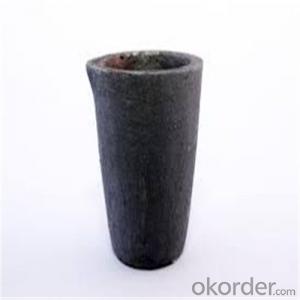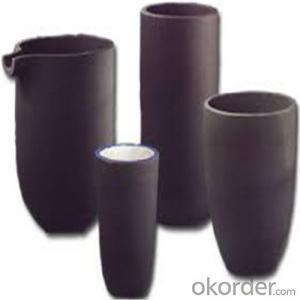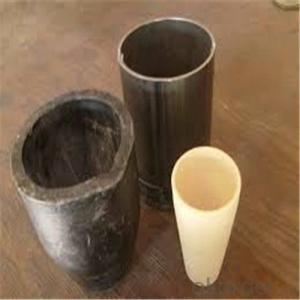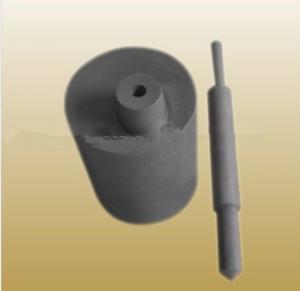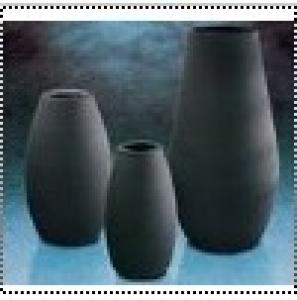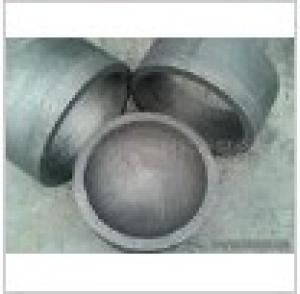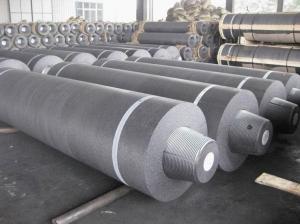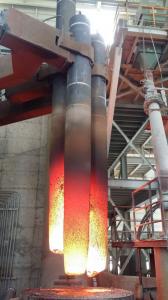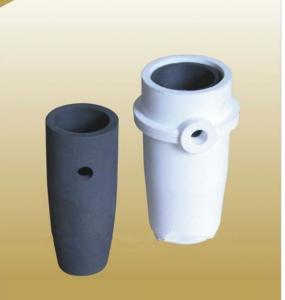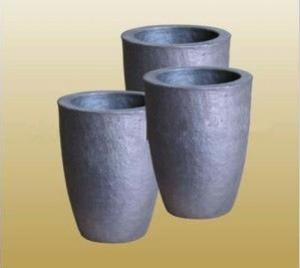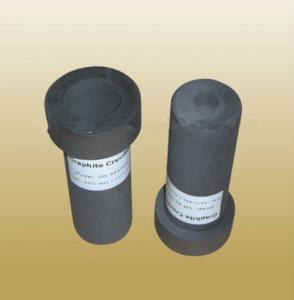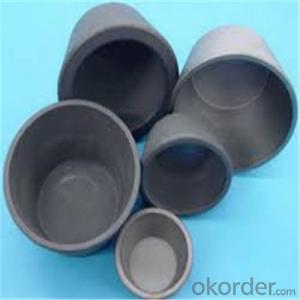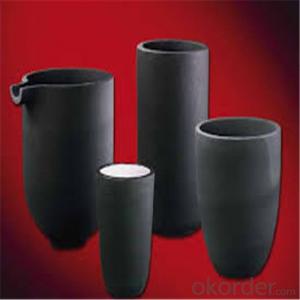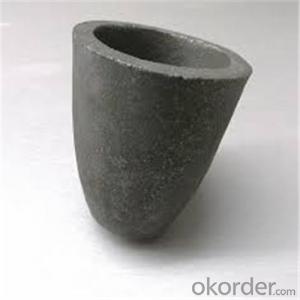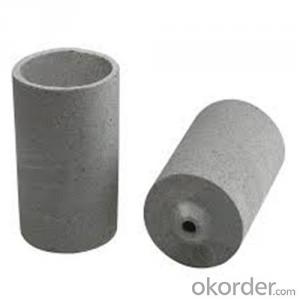Refractory Crucibles Sic Crucible For Melting Copper
- Loading Port:
- Shanghai
- Payment Terms:
- TT OR LC
- Min Order Qty:
- 1 pc
- Supply Capability:
- 1000 pc/month
OKorder Service Pledge
OKorder Financial Service
You Might Also Like
Quick Details for Refractory Crucibles Sic Crucible For Melting Copper/Brass/Aluminum
| Type: | High Strength, graphite crucible crucible | Application: | melting metal | Height: | as your requirements |
| Composition: | High Pure | Top Diameter: | 10-600mm | Bottom Diameter: | 10-1000mm |
| Place of Origin: | China (Mainland) | Brand Name: | Model Number: | ||
| Color: | Black grey | Si3N4%: | 5min | Fe2O3%: | 0.7max |
| C%: | 30-45 | Apparent porosity: | 30max | Refractoriness: | 1680 |
| Bulk Density: | 1.71min | Using life: | >5000 hours | MAX temperature: | 1600c |
Packaging & Delivery
| Packaging Details: | Seaworty packing or as per customer's detail requirement of graphite crucible. |
| Delivery Detail: | within 20-30 days after confirm order of graphite cru |
Refractory Crucibles Sic Crucible For Melting Copper/Brass/Aluminum
Product Description
Specifications for Graphite Silicon Carbide Crucible For Aluminum Melting :
1.Long working lifetime: its working lifetime is increased 3-5 times over normal clay-crucible due to the compact body formed under high pressure.
2.High thermal conductivity: high-density body and low apparent porosity greatly improve its heat conductivity.
3.New-style materials: new heat conduction material ensures faster heat conductivity and pollution-free product, reduces adherent slag.
4.Resistance to corrosion:better anti-corrosion than normal clay-crucible.
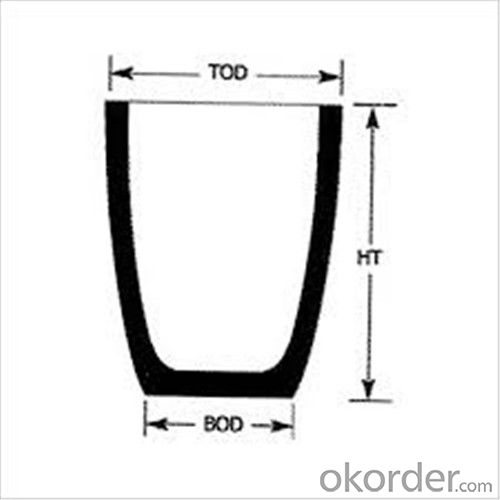

Refractory Crucibles Sic Crucible For Melting Copper/Brass/Aluminum
Physicochemical Properties
Type of Crucible | Type S | Type D |
Carbon Content/% | ≥38 | ≥45 |
Bulk Density/(g/cm3) | ≥1.70 | ≥1.85 |
Apparent Porosity/% | ≤29 | ≤21 |
Compression Strength/MPa | ≥20 | ≥25 |
Refractoriness/°C | ≥1400 | ≥1400 |
Type S: Clay graphite crucible
Type D: Isostatic pressing graphite crucible
Cited from CNS China National Standard of Graphite Crucible, which is solely drifted by TIANFU company.
Content Composition
C% | Sic% | AL2O3% | SIO2% |
45%-50% | 20%-30% | 10%-12% | 15-25% |
FAQ
1.What's your MOQ?
We will indicate the MOQ for each item in the quotation list. We accept the sample and trail order.
2.Can I negotiate the Prices?
Sure, we may consider discounts for bulk order of products.
3.How long will it take to complete my order?
For the stock items, we can arrange the shippment within 2~3days after received your payment. For the customized items, we will indicate the delivery time in the quotation list.
4.Can you give warranty of your products?
Yes, we extend a 100% satifisfaction guarantee on all items. Please feel free to provide timely feedback if you're not satisfied with N&D's Quality and Service. For the overseas orders, if there is a quality problem, please kindly to provide the picturers to show the problem by e-mail. We will provide the replacements to you at our cost according to actual conditions.
5.Can I visit you?
Sure. If you're a volume buyer and would like to visit our in-house products and production line, please contact us to make an appointment.
- Q:Aluminum graphite crucible for iron crucible which is good
- The graphite crucible produced by our factory can live for 6-9 months.
- Q:What are the different methods of preventing contamination from graphite dust?
- To prevent contamination from graphite dust, there are several approaches that can be utilized. 1. Ventilation Systems: It is crucial to install appropriate ventilation systems in areas where graphite dust is produced. These systems play a vital role in capturing and eliminating dust particles from the air, thereby reducing the risk of inhalation or settling on surfaces. 2. Enclosures and Barriers: Creating physical barriers and enclosures around areas where graphite dust is generated can effectively contain the particles within a controlled space. This containment prevents the dust from spreading to other parts of the facility or affecting nearby equipment. 3. Personal Protective Equipment (PPE): Workers who are exposed to graphite dust should wear suitable PPE to minimize contamination. This may include respiratory masks or respirators, goggles, gloves, and protective clothing to prevent direct contact with the dust. 4. Regular Cleaning and Maintenance: Strict adherence to a cleaning and maintenance schedule is essential in preventing the accumulation and spread of graphite dust. Surfaces, equipment, and machinery should be regularly cleaned using methods that minimize dust dispersion, such as wet cleaning or vacuuming with HEPA filters. 5. Process Modification: Altering the production process can also be effective in preventing graphite dust contamination. Implementing measures like wet cutting or machining instead of dry processes significantly reduces the generation and spread of dust particles. 6. Training and Awareness: Educating workers about the hazards of graphite dust and providing training on proper handling, cleaning, and maintenance procedures are crucial in preventing contamination. Workers should be informed about the risks associated with graphite dust exposure and equipped with the knowledge to take necessary precautions. By employing a combination of these methods, facilities can successfully prevent contamination from graphite dust and ensure a safe and healthy working environment.
- Q:Procedures for operating high temperature furnaces
- A, check the power line contact is goodB, check if the connection is normalC, check if the cooling water is normalD, check the tightness is normalE, prepare the necessary tools: dust-free paper, anhydrous alcohol, canvas gloves, operating gloves, masks, high temperature gloves, graphite trolley, stainless steel tray
- Q:Can graphite crucibles be used for melting thermoplastics?
- No, graphite crucibles cannot be used for melting thermoplastics. Graphite crucibles are typically used for high-temperature applications such as melting metals and alloys due to their high melting point and excellent thermal conductivity. Thermoplastics have much lower melting points and require crucibles made of materials such as stainless steel or ceramic to withstand the lower temperatures and prevent contamination.
- Q:Is it possible to achieve controlled pouring with a graphite crucible?
- Yes, it is possible to achieve controlled pouring with a graphite crucible. Graphite is known for its excellent thermal conductivity and high melting point, which allows for precise control over the pouring process. Additionally, the smooth and non-reactive surface of graphite minimizes the risk of contamination, ensuring accurate and controlled pouring of molten materials.
- Q:Graphite products are mainly used in what industry?
- Soft, black, gray, greasy, dirty paper. Hardness is 1~2, along the vertical direction with the increase of impurities, its hardness can be increased to 3~5. The specific gravity is 1.9 ~ 2.3. The specific surface area is concentrated in 1-20m2/g. Under the condition of oxygen isolation, the melting point is above 3000 DEG C, and it is one of the most refractory minerals. It conducts electricity and conducts heat.
- Q:What crucible can be used to make steel? At least 1500 degrees resistant
- At this time, the surface of the liquid pig iron reacted violently, causing iron, silicon, manganese oxide (FeO, SiO2, MnO) to produce slag, using the convection action of molten steel and slag to make the reaction spread throughout the crucible furnace
- Q:Are there any safety precautions to take when using a graphite crucible?
- Yes, there are several safety precautions to take when using a graphite crucible. Firstly, it is important to handle the crucible with care and avoid dropping it or hitting it against hard surfaces. Graphite crucibles are relatively fragile and can crack or break easily if mishandled, which can lead to injury or damage to equipment. Secondly, graphite crucibles should be stored in a dry and clean area to prevent any contamination or chemical reactions. Moisture or impurities can cause the crucible to degrade or react with the materials being heated, compromising its integrity and potentially causing accidents or failures. Additionally, it is crucial to use appropriate personal protective equipment (PPE) when working with a graphite crucible. This includes wearing heat-resistant gloves, goggles, and a lab coat or protective clothing to shield against heat and potential splashes or spills. When heating or cooling the crucible, it is recommended to do so gradually to avoid thermal shock. Rapid temperature changes can cause the crucible to crack or break, resulting in possible injury or damage. Furthermore, it is essential to be mindful of the materials being used in the crucible. Some substances may produce toxic fumes or hazardous reactions when heated in a graphite crucible, so proper ventilation and knowledge of the materials' properties are crucial. Finally, after use, it is important to allow the crucible to cool down completely before handling or storing it. Attempting to handle a hot crucible can lead to severe burns or injuries. By following these safety precautions, the risk of accidents, injuries, or damage when using a graphite crucible can be significantly reduced, ensuring a safe and effective working environment.
- Q:What are the different methods of measuring the temperature inside a graphite crucible?
- There exist several approaches for gauging the temperature inside a graphite crucible. 1. Thermocouples, extensively employed in various industrial settings, including within graphite crucibles, are composed of two distinct metal wires fused to form a junction. When a temperature discrepancy arises between the junction and the other end of the wires, a voltage is produced, which can be quantified to ascertain the temperature. Thermocouples are fairly uncomplicated, cost-effective, and deliver precise temperature readings. 2. Infrared (IR) Pyrometers rely on the concept of thermal radiation to gauge the temperature of an object without establishing direct contact. These devices detect the infrared radiation emitted by the graphite crucible, which is directly proportional to its temperature. IR pyrometers are non-contact and offer rapid temperature readings, making them suitable for instances where direct contact is unfeasible or undesirable. 3. Optical Pyrometers employ the principle of color temperature to determine the temperature of an object. These devices operate by comparing the color of the object being measured to a calibrated scale. By adjusting the scale until the colors correspond, the temperature can be deduced. Optical pyrometers are commonly used in high-temperature scenarios and yield precise temperature readings. 4. Radiation Thermometers, also referred to as non-contact infrared thermometers or infrared thermometers, ascertain the temperature by sensing the thermal radiation emitted by the graphite crucible. Typically, these devices employ a detector to transform the thermal radiation into an electrical signal, which is then processed to ascertain the temperature. Radiation thermometers are non-contact, swift, and provide accurate temperature measurements. 5. Contact Probes, such as thermocouple probes or resistance temperature detectors (RTDs), can be directly inserted into the graphite crucible to gauge its temperature. These probes are typically crafted from materials resistant to high temperatures and are connected to a temperature indicator or controller. Contact probes furnish direct temperature readings and are commonly utilized in situations necessitating continuous monitoring and control of temperature. Each of these methods possesses unique advantages and limitations. The choice of measurement technique hinges on factors such as temperature range, precision requirements, response time, and the specific attributes of the graphite crucible and its contents.
- Q:Can graphite crucibles be used for heat treatment processes?
- Yes, graphite crucibles can be used for heat treatment processes. Graphite has excellent thermal conductivity and high melting point, making it suitable for withstanding extremely high temperatures required for heat treatment. Additionally, graphite crucibles have good resistance to chemical corrosion, which is important when dealing with reactive or corrosive substances during heat treatment.
1. Manufacturer Overview |
|
|---|---|
| Location | |
| Year Established | |
| Annual Output Value | |
| Main Markets | |
| Company Certifications | |
2. Manufacturer Certificates |
|
|---|---|
| a) Certification Name | |
| Range | |
| Reference | |
| Validity Period | |
3. Manufacturer Capability |
|
|---|---|
| a)Trade Capacity | |
| Nearest Port | |
| Export Percentage | |
| No.of Employees in Trade Department | |
| Language Spoken: | |
| b)Factory Information | |
| Factory Size: | |
| No. of Production Lines | |
| Contract Manufacturing | |
| Product Price Range | |
Send your message to us
Refractory Crucibles Sic Crucible For Melting Copper
- Loading Port:
- Shanghai
- Payment Terms:
- TT OR LC
- Min Order Qty:
- 1 pc
- Supply Capability:
- 1000 pc/month
OKorder Service Pledge
OKorder Financial Service
Similar products
New products
Hot products
Hot Searches
Related keywords
